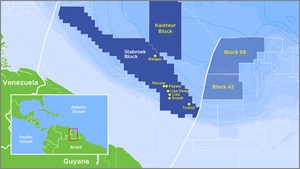Chevron gains 30% stake in Guyana’s “hottest” oil patch with $53 billion Hess acquisition
(Bloomberg) – The crown jewel of Chevron Corp.’s $53 billion acquisition of Hess Corp. is a piece of larger competitor Exxon Mobil Corp.’s prized asset — 11 Bboe off the coast of South America.
Chevron is gaining a 30% stake in Guyana’s Stabroek Block, home to the world’s largest crude oil discovery of the past decade and one of its most profitable. The purchase helps the California oil giant narrow the gap with its larger U.S. competitor, which owns 45% of the block, operates the project and made its first discovery in 2015. China’s CNOOC Ltd. owns the remaining 25%.
Chevron’s willingness to pay a premium for Hess even after the shares nearly doubled last year shows that the U.S. supermajors are ready to use their financial heft to secure low-cost oil supplies for the long term. Guyana is attractive not just for the size of its discoveries, but also for its breakeven costs, which are some of the lowest for new offshore developments anywhere in the world.
“It’s one of the best,” said Marcelo de Assis, the head of Latin American upstream research at Wood Mackenzie Ltd. “There is still more to come, so there is still potential there in terms of growth.”
Guyana’s oil production is on course to triple to 1 MMbpd by the end of the decade, a rapid expansion for a field that pumped its first barrel at the end of 2019. That would put the country of 800,000 people on par with OPEC-member Angola and make it one of the most resource-rich countries per capita in the world.
“Guyana is the biggest discovery in more than a decade in this industry,” Chevron Chief Executive Officer Michael Wirth said in an interview with Bloomberg Television. “It just a unique and compelling asset, and it would be difficult for us to do on our own.”
Wirth and his American peers have warned that more investment is needed in fossil fuels, even as investors push them to use cash on buybacks and dividends and politicians call for low carbon sources of energy. With banks and investors unwilling to fund new projects, acquisitions appear to be the go-to strategy for oil companies with enough financial firepower.
The all-stock transaction, in which Chevron is paying 1.025 of its shares for each share of New York-based Hess, is expected to close in the first half of 2024. Shares of San Ramon, California-based Chevron slid 3.7% to $160.68 in New York trading, while Hess fell 1.1% to $161.30.
Earlier this month, Exxon agreed to buy Pioneer Natural Resources Co. for $60 billion to overtake Chevron by becoming the top producer in the Permian, America’s biggest oil field. The Chevron and Exxon megadeals put the two U.S. oil giants firmly in control of two of the fastest-growing production zones outside of OPEC: Guyana and the Permian.
For decades, Guyana lived in the shadow of its larger neighbor Venezuela in terms of oil production and influence. Dozens of wells drilled in its shallow waters came up dry, and territorial disputes between the two countries hindered exploration activity. Just before its license was due to expire, Exxon decided to drill the first exploration well in Guyana’s deep water in 2015, but its 50-50 joint venture partner Shell Plc pulled out.
Exxon’s then-CEO Rex Tillerson called John Hess, who agreed to take a 30% position in the block and put up the money for the Liza 1 well, named after a local fish. It was a monster success, encountering 295 feet (90 meters) of oil-soaked sandstone that Exxon upstream boss Neil Chapman later described as a “fairy tale.” Dozens more discoveries on the block followed. Other producers have drilled exploration wells in Guyanese waters outside of Stabroek but have so far come up short.
“Not all acreage is created equal in Guyana,” said Schreiner Parker, head of Latin America for Rystad Energy. “Due both geology and fiscal terms, there is Stabroek and then there is everything else. Chevron wanted Stabroek.”



